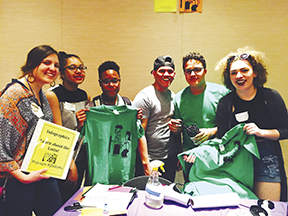ASA Experts Make Meaningful Contribution
Abigail Kirchman, Mathematics Teacher at The James Baldwin School

From Left: Abby Kirchman, Amari Wilder, Zoie Rodgers, Michael Camarena, Mario Serrano and Mikayla Cardinali
“New York Lottery: Hey, You Never Know” signs stick to the windows of bodegas and grocery stores. Coins etch at scratch-off cards on the train. This is what my students and I see every day in New York City.
At The James Baldwin High School, we are encouraged to learn and teach using relevant contexts. This semester, my students and I studied probability and statistics grounded in the lottery scene. We calculated the probability of winning the Powerball, determined the best scratch-off ticket in New York, and considered whether the lottery hurts or harms communities.
Student inquiry is central to our learning and teaching philosophy. When studying the Powerball, students created a list of questions. They were curious about the history of the game and wanted to know what to do if they won. Some wanted to compare the chances of winning to other unlikely events, and others were fascinated by the sheer size of the calculated numbers. Based on their questions, the students worked in groups to research and create infographics to share their findings.
During our study of the Powerball, I assigned an article for homework: “A Statistician’s View: What Are Your Chances of Winning the Powerball Lottery?” On the off chance that he would respond, I emailed the author—ASA Executive Director Ron Wasserstein—asking that he might provide additional information about the lottery for my class and give feedback on our projects. One month later, Wasserstein was Skyping into our classroom and sharing thoughts on our infographic project. Days of editing and revising ensued as students worked to incorporate this feedback and convey their understanding of the Powerball.
Often, school work ends here. The project is graded and we move on to a new topic. At James Baldwin, however, we hope to share our work and celebrate our learning. My class had the opportunity to present at the NYC Social Justice Expo. The Social Justice Expo brings high-school students from around New York City together to share projects related to social justice issues. Here, students shared science experiments related to water quality, sold buttons to raise money for Nepal disaster relief, and participated in debates about stop-and-frisk. Thanks to donations from the American Statistical Association, my students were able to screen print lottery T-shirts with their own design and give them out to crowds of teenagers. I watched as my students explained their work to students, teachers, and advocates, building awareness about the lottery. Students felt the importance of their work. Our learning had relevancy.
Students come to The James Baldwin High School for a variety of reasons, but they all have one thing in common: It is their second chance at high school. As a teaching community, we design engaging classes that spark curiosity and demand critical thinking. Students do not sit passively, fill a notebook with teacher-created notes, or do problem sets of 58 problems. Rather, students are writers, artists, mathematicians, and scientists.
We work to connect students with experts in our fields and seek authentic audiences for our projects. It is impossible to engage in this work without the support of the greater community. Our networks—New York City Outward Bound Schools and the Consortium—provide philosophical grounding and instructional guidance. Donors choose funded classroom supplies such as notebooks. But perhaps the most visible and meaningful contributions for the students are the connections we make with experts in the field. Thank you from my class to Ron Wasserstein, Donna LaLonde, and The American Statistical Association!










 (3 votes, average: 4.33 out of 5)
(3 votes, average: 4.33 out of 5)






